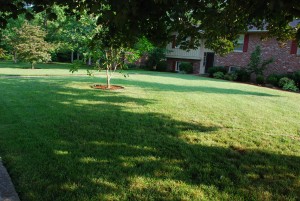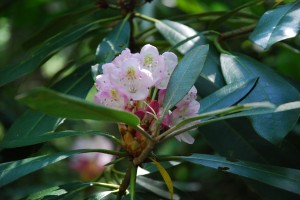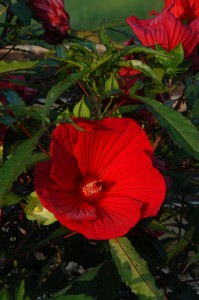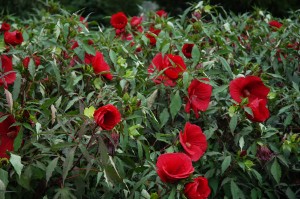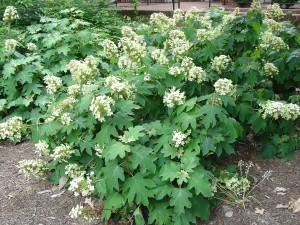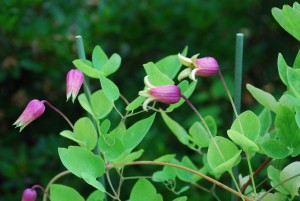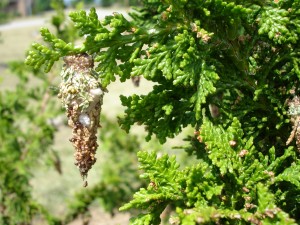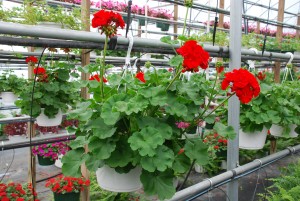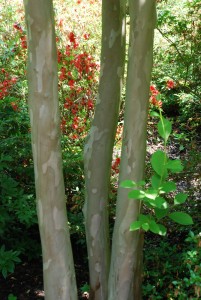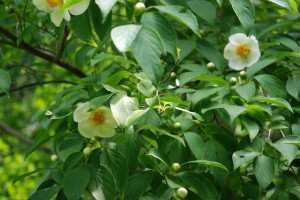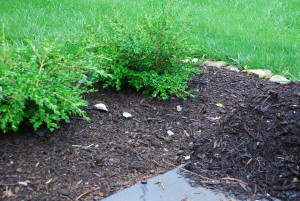July Lawn Care
Rosebay Rhododendron for Cool Shady Landscapes
Rosebay Rhododendron (Rhododendron maximum) grows in dense woodland shade along cool mountain streams and on moist, rocky slopes. This Southern Appalachian native is extremely winter hardy to -15° to -20° F. It is a late-season bloomer reaching its peak around late June.
Rosebay grows large, 15 to 20 feet in height. On some sites it is not unusual to see tree-like rosebay rhododendrons to 40 feet. The plant habit is spreading, broader than tall. Leaves are large, 4 to 12 inches long, glossy dark green. The new growth feels sticky to the touch.
The inflorescence (truss) of 15 – 30 funnel-shaped flowers. Each 5-lobed flower is approximately 1 inch long, white to pale pink (occasionally deep pink to rose red). The flower trusses lack fragrance.
Rhododendrons prefer a moist, compost rich, acidic soil which drains well. Organic based acidic mulches, such as pine bark or pine needles, will cool and conserve soil moisture.
Many hybrids, using Rosebay as a parent, includes a personal favorite ‘Maxecat’ which blooms in early June from eastern Pennsylvania south to northeast Tennessee. Blooms open light pink and fade to white.
Where Can I Buy That?
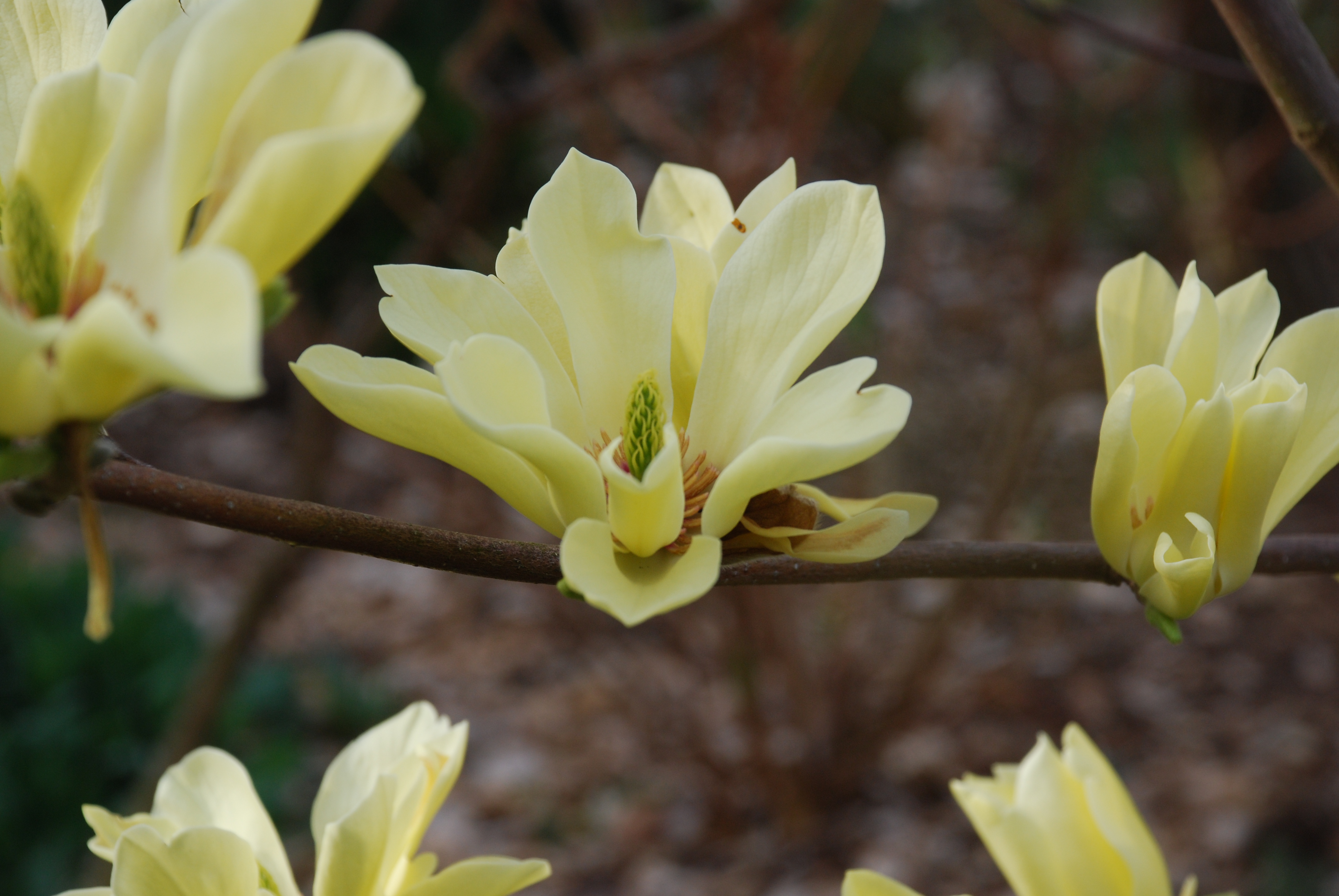
Let’s face it – rare and unusual plants are not likely for sale at your local garden center. Full service garden centers located in large metropolitan areas may sell one or two.The internet has become the best plant finding source. Some on-line purveyors may carry a rare item, but not sell it in large quantities. High sticker shock may chase you away. If the plant (tree, shrub, vine, perennial, tropical) is new or very rare, the nursery may price it higher. The principle of “supply & demand” applies here.
Several months back, a reader of “What Grows There” asked where she could purchase pink flowering forms of Chinese dogwood (Cornus kousa) for a friend living in northern Ohio. A pink cultivar (listed under 3 cultivar names: ‘Miss Satomi’, ‘Rosabella’ and ‘Heart Throb’) was cited at four rare plant nurseries. Radiant Rose® (maybe ‘Miss Satomi’) was also listed.
Another reader was interested in purchasing one of the hybrid yellow flowering magnolias (Magnolia x). Here are four on-line nurseries where I founded both plants listed:
Fairweather Gardens P.O. Box 330, Greenwich, NJ 08323
Forest Farms, 990 Tetherow Rd., Williams, OR 97544
Gossler Farms Nursery 1200 Weaver Rd, Springfield OR 97478
RareFind Nursery, 957 Patterson Road, Jackson, NJ 08527
Flaming ‘Fireball’ Hibiscus Quite A Summer Show
‘Fireball’ hibiscus (Hibiscus x moscheutos ‘Fireball’) is a vigorous hardy perennial with burgundy tinted cutleaf foliage and huge 10-12 inch clear red flowers from mid-summer to late summer.
Plant height is 4 – 5 feet and 2 – 3 feet in width. A strikingly beautiful plant, ‘Fireball’ thrives on heat and humidity. It wants full sun and a moist well drained soil to reach its full flowering potential. Expect hundreds of blooms on 3-4 years old established plants grown in a richly amended composted soil and kept irrigated.
Flowers are both huge and showy. Blooms are the size of dinner plates. A prominent pistil and stamen is in the center of each flower. Each bloom lasts but one day, but ‘Fireball’ blooms almost nonstop from July to early September.
Hardy hibiscus demands heat, moisture and long days. They are late to emerge from the soil, many years after May 15th in the Southern Appalachian region (USDA zones 6 and 7). Feed them regularly with a water soluble 20-10-20 fertilizer (or equivalent). Hibiscus sawfly, mites, and aphids may be serious nemeses.
This late flowering habit makes hardy hibiscus ideal companion plants to interplant with spring blooming bulbs like daffodils and tulips.
Fireball™ is one of several hardy hibiscus bred by the Fleming Brothers in Lincoln, Nebraska. It was their favorite perennial.
Summer Pruning of Oakleaf and Bigleaf Hydrangeas
Bigleaf or “mophead” hydrangeas (Hydrangea macrophylla) tend to get tall and leggy, and outgrow their garden space. Our native oakleaf hydrangeas (Hydrangea quercifolia) are pruned as blooms quality declines. Remove or “deadhead” all withered or faded flowers. Main pruning time for these two species is from mid-June thru mid-August. Mopheads may rebloom if they had been deadheads by mid-summer, again in September.
These two hydrangea species set their flower buds for next spring on old or current season’s growth on the terminal bud. Pruning in the fall or winter may remove flower buds or stimulate soft late shoots which die over the winter. Make all cuts 1/4 inch above the last set of leaves or cutback flush to a main branch.
Pruning improves the health of the plant, increasing vegetative growth. On older 4-5 year old hydrangeas, remove larger, thicker canes and prune them at the base of the stem. Remove one-quarter to one-third of these older branches. In 3-4 years the hydrangea will be completely rejuvenated.
Dead, dying, diseased stems and flowers can be removed at any time of year.
Leather Flower Clematis- Hot Pink Summer Flowering Vine
Leather flower (Clematis glaucophylla) is native to moist woodlands in the Southeastern U.S. This lovely flowering vine is covered with one inch hot pink flowers tipped in yellow. The solitary, 1- inch bell shaped flowers are on 6- inch long stalks which reach out for support. It is called “leather flower” because the petals are thickened almost like a thin banana peel.
A mature vine may open a hundred or more flowers at one time. Leather flower blooms from June to October if kept moist. Its clematis seed heads are uniquely showy. Leather flower is also a hummingbird magnet.
Plant it in good composted soil with adequate moisture and partial sunlight. In zone 6-a (eastern PA) it grows in full sun, and moving further south, provide more shade. Let it grow on a trellis or along a fence or rail. Allow it to weave through a tree or ramble at will. The vine clings by wrapping its leaf stems (petioles) around the supporting structure.
A 2 -year established leather flower grows 12 – 15 feet. Flowering occurs on new growth only. Aggressively prune a dormant vine in late winter (Pruning Group 3), cutting back each main branch to two strong buds close to the ground.
Availability: Sunlight Gardens in Andersonville, TN. Order through the website: www.sunlightgardens.com
Bagworms Can Devastate Evergreens
Bagworms feed on more than 128 species of plants, including junipers, cedars, arborvitae and white pine. More than one year of severe defoliation will kill a formerly healthy specimen. Bagworms have one generation per year. Eggs usually hatch in mid to late May across the Southern Appalachian region (USDA zones 6 and 7).
Upon hatching, the young larvae crawl out of the bottom of the bag and begin eating plant foliage. Maturing larvae can do considerable defoliation during early summer. As the worms age, they construct a silken shelter over their body and are more difficult they are to kill.
Bagworms’ carrot-shaped bag is constructed of bits of material from the plant upon which it’s feeding and expands as the bagworm grows. The bag is carried wherever the worm goes. When disturbed, the bagworm merely pulls its head back into its bag for protection.
Insecticides should be applied when the bagworms are small, but after all have hatched by early June. After mid-June pesticide control is too late. Complete spray coverage is essential. Carbaryl (Sevin), Bt (Dipel), Malathion, acephate (Orthene), and pyrethroids like bifenthrin (Talstar), cyfluthrin, and permethrin), and spinosad (Conserve SC) are highly recommended. Spinosad controls the hard to kill older bagworms.
Calliope™ Dark Red Geranium- One of the Best
Garden performance is very important. Calliope™ Dark Red geraniums have it!! Calliope geraniums are interspecific hybrids with zonal-type leaves and huge vibrant red flowers. Plant breeders crossed ivy geraniums (the kind commonly used as hanging baskets) and zonal geraniums (found growing in pots, window boxes, and as bedding plants).
Calliope is a vigorous grower with a mounding to semi-trailing growth habit. A local East TN grower describes Calliope as “a geranium on steroids”. Newest in the Calliope series is ‘Scarlet Fire’ with bright red blooms. Both cultivars branch exceptionally well.
Calliope combines well with yellow and blue flowering annuals. Calliope demonstrates excellent heat tolerance in the landscape. In the Southern Appalachian region (USDA zones 6 and 7). Locate Calliope where it receives full morning sunlight and partial shade in the afternoon. Summer watering and feeding container grown geraniums are crucial.
Calliope Dark Red is a moderate to heavy feeder. Feed plant(s) every two weeks with a soluble plant food such as 20-10-20 (or equivalent) to soil or potting medium. Alternatively, you may feed geraniums with a granular slow-release fertilizer every four to six weeks.
Pinching off old spent blooms at the base of the stem encourages continuous flowering and plant growth. Pinching also reduces the chances of floral and leaf spot diseases.
Stewartia- A Tree for All Seasons
Japanese stewartia (Stewartia pseudocamellia) is a truly beautiful 20-30 foot small tree or multi-trunked shrub. Stewartia may be finicky to grow, but a great plant nonetheless. Although rarely seen in U.S. gardens, Japanese stewartia is the most commonly grown of the six stewartia species. All are winter hardy in the Southern Appalachian region (USDA zones 6 and 7).
Visually, stewartia provides four seasons of ornamental beauty. Lovely 2 to 2 ½ inch camellia-like white flowers appear in early June and are in bloom for 2 – 3 weeks. The 3 – 4 inch blemish-free green summer foliage turns yellow and/or crimson red in mid- autumn, depending on its location. Its patchwork mottled bark becomes more attractive with age.
The trick to growing stewartia is selecting a proper site. Stewartia may flourish for many years if the soil drainage and sunlight exposure are near perfect. Japanese stewartia grows similar to flowering dogwood (Cornus florida), requiring a compost rich, acidic pH and almost perfectly drained soil.
Filtered all-day sunlight or six hours of morning /early afternoon sunlight is ideal. Prolonged periods of scorching summer heat and low rainfall may be fatal to Japanese stewartia. Irrigate to cool and refresh the tree(s) and keep adequately mulched.
Does Mulch Attract Termites?
Mulching, in itself, does not attract termites to your home. That’s the conclusion of two university studies. Soil moisture appears to be the key factor that attracts termites to the home. The subterranean termites found in scattered, localized areas are routinely found in wood chip mulch.
While landscape mulches are good for woody and herbaceous plants, they’re admittedly favorable for termites and other insects as well. Soil moisture favors termite exploration, tunneling and feeding.
University of Maryland entomologists found that termite populations were detected beneath many kinds of mulches, including eucalyptus, hardwood, pine bark, and pea gravel. However, termite activity was significantly higher beneath the gravel mulch. Scientists concluded that termite activity is more about a suitable habitat.
A University of Florida study reported that termites can be found in mulch, but their survival is poor. Why? – because the ability of termites to survive the chipping process that manufactures mulch is not good. Mulch-fed termites suffer significantly lower survivorship.
Overall recommendations: Keep mulch 12-18 inches away from the house foundation. Termites do need a cellulose materials like mulch to feed on. Always watch for signs of termites and their location (activity) around your home.

